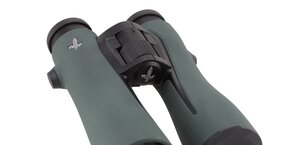Swift Optics 962 Ultra Lite 10x42
When it comes to the optics, prisms, made of BaK-4 glass and put in the Porro system were used. All the elements were covered by new, specially designed multi-coatings which is supposed to ensure an especially high transmission level. Additionally, the eyepieces are constructed in such a way so they give sharp field of view up to the edge and a comfortable eye relief at the same time.
The binoculars are waterproof and they come with a 25-year-long guarantee.
| Magnification | Lens diameter | Angular field of view | Prisms | Eye relief | Weight | Price |
|---|---|---|---|---|---|---|
| 10 | 42 | 96/1000(5.5o) | BaK-4/Porro | 18 mm | 710 g | 1016 PLN |
Summary
Pros:
- solid housing and original design,
- practically imperceptible distortion,
- very good transmission,
- sharp image in almost all field of view,
- very low coma,
- slight astigmatism,
- chromatic aberration very well corrected,
- high quality of anti-reflection coatings and BaK-4 prisms,
- good whiteness rendition,
- long warranty period.
Cons:
- distinct flares,
- the field of view could have been wider.
Once again we have here an interesting duel between four very good and very similar sets of binoculars. In alphabetical order these are as follows: the Bynolyt Seal 10x42 BCF, the Olympus EXPS-I 10x42, the Opticron Imagic TGA WP 10x42 and the Swift Optics 962 Ultra Lite 10x42. All of them are classic Porro devices, with their dimensions very much alike. Their weight is in the 670-785 grams range, their fields of view amount to exactly 5.5 degrees and eye relief distances – from 18 to 21.5 mm. The most curious thing is that even their market prices in Poland don’t differ greatly – they range from 650 to a bit over 1000 PLN (arount 250-300 USD).
Looking at these binoculars and their parameters we see at once that their potential is great. First of all we deal here with an efficient and simple Porro construction which, for an amount of about 250-300 USD, can offer a lot. Apart from that, the limited field of view of 5.5 degrees allows us to expect no serious slip-ups at its edge.
None of these binoculars disappointed us and the Swift came out very well indeed, showing a sensational price/quality ratio. The Bynolyt and the Opticron had bad luck here – if there was no Swift we would speak about them very warmly. The Olympus has one solid advantage – the lowest price; it might seriously influence the interest in this instrument. All the binoculars have plenty of advantages but the Swift has significantly more of them. As it costs almost the same or a tad more than the rivals, the choice is really rather simple unless somebody doesn’t like its original housing and a bit heavier weight (although personally I doubt anybody would mind a difference of 20-40 grams).
If I started to get interested in a product of the 10x42 class only one thing would make me feel anxious – that field of view, amounting to 5.5 degrees. There’s no doubt that good results of those four sets of binoculars are partially the effect of such a narrow field. Most of the 10x42 instruments have a field of view at the level of 6 degrees and we can even find models with the value of 6.5 degrees. Personally I wouldn’t accept a field of view of 5 degrees in a pair of binoculars with the magnification 10x and the 42 mm objective lens – I am not very keen on such instruments because their eyepieces’ field of view is so small that I have the impression of looking through a narrow pipe. Fortunately when we increase the field from 5 to 5.5 degrees that impression disappears and it seems that the angle of 5.5 degrees is the minimum I would be able to accept because I get a lot in return for its restriction.
The Allbinos.com/Optyczne.pl editorial team decided to award this set of binoculars the distinction “ A good buy according to the Allbinos.com/Optyczne.pl Editorial Team” for winning the 1st place in the 10x42 binoculars Ekono ranking

















